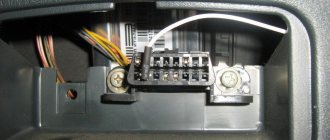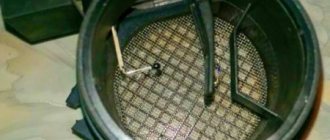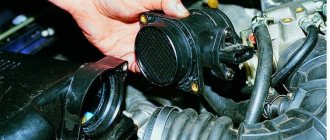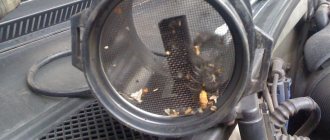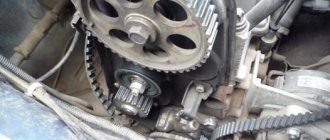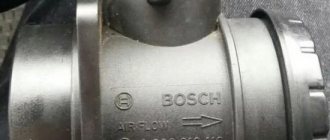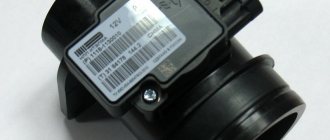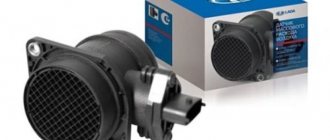The mass air flow sensor (MAF for short) shows how much air is filled in the cylinders when the engine is running. The mass air flow sensor is connected to the electrical harness of the 6-pin block and is located in the space between the air filter and the throttle valve. It is needed to measure the load on the engine and to ensure that fuel is supplied in the required quantity (to monitor this process, you just need to determine the mass of incoming air).
DMRV VAZ 2114
The MAF is of wire (thread) and film type; the fundamental difference is that for the wire type MAF the sensitive element will be a platinum wire, and for the film type there will be a film on which the measuring platinum resistor is attached. Regardless of the type, the mass air flow sensor tends to become dirty (platinum elements become covered with dust and do not work properly). Let's figure out how to clean the mass air flow sensor one by one.
The main reason for contamination of the air flow sensor is the condition of the air filter! If it is not good, then it begins to let in grains of dirt and dust with the air flow, which settle on the sensitive element of the sensor.
Cleaning the air flow sensor is required if:
- At idle the engine runs intermittently,
- The idle speed is unrealistically off the charts,
- When accelerating, it “stutters” (jerks or runs intermittently),
- Benz is consumed in large quantities,
- You basically can't start.
It also happens that the sensitive element itself is fine, but the connection between the sensor and the throttle module is malfunctioning (the connecting hose may crack). And this is a completely different story. Also, the controller may issue a check engine, which may indicate the same breakdown in the sensor connection circuit (or may indicate a completely different breakdown).
Every owner of a Russian car understands that, despite the obvious signs of a malfunction in a particular part of the car, these signs can relate to any other malfunction. Therefore, trust the signs, but check with specifics.
How to check the air flow sensor (3 ways to check)
In some cases, to check the mass air flow sensor, it must be removed from the car. Dismantling procedure:
- Loosen the clamp
- Remove the air pipe,
- Unscrew the screws securing the sensor to the air filter housing.
- Before disconnecting the electrical connector, you must remove the negative terminal from the battery. This must be done so that the electronic engine control unit does not generate an error and the check lamp does not light up.
Method number 1. Visual control
To do this, you need to remove the sensor and carefully inspect it for mechanical damage or foreign objects or debris. It is also worth visually assessing the integrity of the heating filament sensors or heating film.
Such problems can arise due to a leaky air filter housing, or due to a poor-quality air filter.
If visible damage is detected, the sensor must be replaced. And if there is debris or dirt in it, the air flow sensor can be cleaned with special means (alcohol-based spray). Mass air flow sensors are very fragile, so be careful not to clean them mechanically. The sensor cannot be repaired!
Method number 2. Power off
The easiest way to check the mass air flow sensor is to disconnect power from it. With the engine not running, disconnect the electrical connector on the mass air flow sensor. Then we start the engine.
In this situation, the engine control unit switches to backup mode and replaces the readings of the disabled sensor with those programmed by the manufacturer.
In this case, engine operation should normalize and idle speed should increase. For additional checking, you can drive a car with the MAF connector disconnected - 100-200 meters. If all symptoms of a malfunction of the mass air flow sensor have disappeared, then the sensor is transmitting incorrect data - it is considered inoperative and requires replacement.
When checking the mass air flow sensor in this way, after disconnecting the electrical connector from the sensor, the “Check” engine error lamp will light up on the instrument panel.
After completing the check or replacing it, you will need to reset the error! To do this, you can disconnect the negative terminal of the battery for a few minutes (carefully, absolutely all settings will be lost). In some car models, the error can only be reset at a service center using a special scanner connected to the car’s diagnostic connector
Method number 3. Checking with a multimeter
To check the air flow sensor with a multimeter, you need to know which parameters to measure and from which contacts of the electrical connector. They may differ for each car brand. The location of the sensor wires and terminals can be found in the vehicle's electrical diagram.
For example, on Bosch sensors that are installed on VAZ and GAZ cars, you can check the voltage (V) between the incoming signal and ground at the mass air flow sensor connector. To do this you need:
- Turn on the car ignition, but do not start the engine,
- Connect the red (+) probe of the multimeter to the yellow wire,
- The black (-) probe goes to the green wire of the connector.
- We set the mode switch on the multimeter to measure the minimum direct current.
The voltage at the contacts should be in the range of 1.00-1.04 Volts. If the readings are higher, the sensor requires replacement.
Additionally, you can remove the sensor without disconnecting the electrical connector and apply a stream of air to the sensor from the air filter side. The voltage should increase to 1.3 Volts, in which case the air flow sensor is considered working.
Depending on the sensor design, it is still possible to measure the resistance on the resistors. Moreover, the measurement results at different air temperatures will be different. Accurate data on the optimal values of resistance readings, measurement temperatures and the location of contacts on the connector are usually indicated either in special technical literature or in the car repair instructions.
How to use?
Cleaning the air flow sensor must be performed whenever the air filters are changed. The sensor itself is located in the air channel between the filter box and the throttle body. Using a special tool, the device is carefully disconnected from the electrical connectors.
Some brands of cars are equipped with mechanical flow meters. They do not have measuring wires, and therefore are less sensitive to the thoroughness of dismantling.
Next, 10 to 15 sprays are applied onto the wire or sensor plate. The composition is applied to all sides of the sensor, including terminals and connectors. Platinum wires are very thin, so they cannot be wiped. After the composition has completely dried, the device can be returned to its original place. A good spray should not leave marks or streaks on the surface of the air flow sensor.
Checking the mass air flow sensor
All the intricacies of the process of washing the engine and engine compartment of a car
Before starting experiments, do not be lazy to read the service manual. It describes in detail what a mass air flow sensor on a VAZ 2114 is and how to replace it.
We are looking for a sensor. Open the hood and find the air filter pipe. The mass air flow sensor is located on it, which determines the flow of air passing through the filter. I will give several options on how to check the mass air flow sensor yourself.
- Disable the sensor. Disconnect the block with wires from the connector by pressing the latch located below. Start the engine (1500 rpm or more). The controller understands the shutdown of the mass air flow sensor as an emergency condition and prepares the fuel-air mixture based on the position of the throttle valve. Try driving a short distance. If the car accelerates noticeably faster, this indicates a non-working mass air flow sensor. I would like to note that in the disabled state for ECUs Y7.2 and M7.9.7. RPM doesn't increase!
- Replacing the controller firmware. The original ECU firmware could have been replaced with an alternative one. In such a situation, we do not know which algorithm is prescribed in the case of operation in the mode discussed in the first paragraph. The throttle valve has a stop under which you need to place a thin plate (about 1 mm) to raise the speed. Then you need to disconnect the chip with the sensor. If the sensor is faulty, the engine should stall. If the engine is running, then the reason is due to the firmware features: the IAC steps are written incorrectly.
- Voltage measurement. Testing gives good results when working with Bosch sensors. You will need a multimeter. Select the DC voltage measurement mode and set the maximum value to 2 V.
The connection diagram for the VAZ 2114 looks like this:
- yellow – incoming signal;
- gray with white – power output;
- green – grounding;
- pink with black – output to the main relay.
The colors may be different, but the sequence of connectors is the same.
Next, you need to turn on the ignition with the engine off. Connect the red (positive) probe of the tester to the yellow output, and the black (negative) probe to the green. Multimeter probes are inserted along the specified wires directly through the rubber seals of the connectors without damaging the insulation. For prevention, I recommend moistening the probes with WD-40. Intermediates or needles are not recommended due to the additional error they introduce. Measure the voltage. Compare the result with the table:
| Voltage, V | State |
| 1,01 – 1,02 | Good. The sensor is almost new and will last a long time. |
| 1,02 – 1,03 | Satisfactory. The sensor is old, but works properly. |
| 1,03 – 1,04 | Bad. The resource is almost exhausted. Will have to replace it soon. |
| 1,04 – 1,05 | Deplorable. The resource has been exhausted. Suitable for use if there are no alarming symptoms. It is advisable to replace |
| 1.05 – and above | Emergency. The sensor is faulty (possibly for a long time). Replacement is required. |
A newly installed sensor gives an output voltage of 0.996–1.01 V. Over time, it increases. A higher value means a higher percentage of wear.
Voltage data from the sensors is recorded by the on-board computer and can be viewed by selecting the appropriate group of parameters.
Inspection and cleaning. Use a Phillips screwdriver to loosen the clamp holding the air intake pipe. We remove the corrugation and check whether there are traces of oil and/or condensation inside it, as well as on the inner surface of the sensor. Normally they shouldn't be there. The sensing element of the mass air flow sensor often breaks due to dirt getting on it. This can easily be avoided by regularly replacing the air filter. Reasons for oil getting into the air flow sensor:
- the permissible oil level in the crankcase has been exceeded
- The oil separator of the ventilation system is clogged
The sensor is attached to the pipe with two screws. We unscrew them with an open-end wrench (x10) and remove the sensor itself. There is an entrance at the front, which must be protected from the leakage of untreated air with an o-ring rubber seal. If it is missing or remains in the filter housing, dust clogs the sensor input grid. It needs to be cleaned, the seal installed, the leaks checked and the sensor put back in.
Comparison with a working sensor. From personal experience, I was convinced that the most accurate test is to install a sensor that is known to work and compare the behavior of the engine with the “native” one.
In addition to the options considered for how to check the mass air flow sensor yourself, you can also contact a service center that has special equipment and carry out 100% diagnostics, for example, using the method of evaluating an oscillogram.
Symptoms and troubleshooting
Since the mass air flow sensor is electronic equipment, and a very complicated one at that, most car owners do not dare diagnose it themselves and take it to a car service center the old fashioned way. But quite often, having just connected the diagnostic device to the sensor, the auto repairman declares that the device is completely faulty, it cannot be repaired, and its place is only in a landfill. Rest assured, if you bring in a completely new sensor, the technician will tell you the same thing.
But any disinterested expert will say that the mass air flow sensor is an almost indestructible device. It may malfunction, sometimes seriously, but this is a completely fixable problem, something that will take no more than an hour. But how to check the mass air flow sensor for performance? Very simple. If, after installing a new sensor on your car, you notice that it works perfectly, then that is where the problem lies. If the situation has not improved at all, then there is no point in wasting your energy, time and money on the empty hassle of replacing a completely “healthy” sensor.
Just above we mentioned such a device as a multimeter. You can understand whether the sensor is working or not by finding out the voltage of the device. If everything is normal, then the multimeter produces 1-1.2 W. If there are any problems, then the scale goes down, the critical mark starts at 0.99 W. If, on the contrary, the voltage is higher than normal, for example 1.037, then this indicates one thing: the sensor is very clogged, and therefore makes errors in the readings. If you clean it, it will work again at the same rate.
First of all, this is a sharp increase in fuel consumption. Here you should not blame the car for its large “appetites”: it is not to blame, and the manufacturer is not to blame, here you just need to “treat” your “iron horse”. Of course, this can happen not only in the case of a sensor failure, but from this fact alone you can come to the right idea: most likely the problem lies in the tiny device.
Also, when the engine loses power, a hot engine will stop starting. The car, previously dynamic and controllable, turns into some kind of monster on wheels, which is constantly lost in control and “freezes”. And finally, if you see a simple Check Engine sign on the instrument panel, then there can be no doubt: this sensor is asking you for an ambulance.
We clean the mass air flow sensor ourselves
Checking high-voltage ignition wires: subtleties of the process
MAF (mass air flow sensor) is perhaps the most expensive part that is present in the entire engine management system. This is precisely the reason for the fact that numerous sellers of automobile parts loudly say that this element cannot be repaired and that only its replacement is possible. But it is not all that bad. There is a fairly simple solution that can help in what seems to be the most hopeless situation - cleaning the mass air flow sensor, and this is what will be discussed in this material.
What is this unit
The mass air flow sensor is a device designed to measure the amount of air that enters the VAZ engine. But it is worth noting that the device does not measure its volume, but only determines the mass that passes per unit of time. The device is located between the air filter housing and the air pipe leading to the throttle valve, and the sensor itself can be used on both diesel and gasoline engines.
When is it necessary to clean the air flow sensor?
Everyone knows that the high-quality and productive operation of the 2112 engine, as well as fuel consumption, largely depend on how correctly the process of mixing it with oxygen occurs.
That is why, the breakdown of this unit can cause serious problems in the power unit and, over time, completely disable it. Main symptoms of a malfunction:
- Uneven, jerky and intermittent operation of the 2110 engine at idle;
- Problems with acceleration dynamics;
- Excessively low or high idle speed of the power unit;
- Inability to start the engine.
There are other signs when, in fact, the flow meter itself is in perfect order, but there are cracks in the corrugation connecting it to the throttle module. Problems and malfunctions in the operation of the mass air flow sensor can be identified by signals from the controller and the CHECK ENGINE indicator lamp. However, deciphering the displayed code yourself is quite problematic and it is better to turn to a professional for this service.
Cleaning procedure - step by step instructions
It's time to figure out how to clean the mass air flow sensor. First of all, you should remove its pipe and, using a set of star keys, unscrew the screws and remove the sensor from the housing. The extraction procedure is mandatory - without it, there can be no talk of any high-quality cleaning. After dismantling, we carefully examine the condition of the device. Quite often it is almost completely covered with oil - both inside and outside. A special MAF cleaner will help you deal with it, which can be purchased today in almost every car store.
Pay special attention to the fact that inside, on the film, there are several sensors that are fixed to the surface using a special resin. Be careful with them - any sudden or incorrect movement can lead to damage
So, we spray them with liquid from a can from a distance of about 10 cm and wait until the product dries. Depending on the degree of contamination of the sensors on 2114, we repeat this procedure several times. In order to speed up the drying process, you can use a compressed air compressor. However, the time savings will not be very significant, so there is little point in additional costs.
In addition to the sensor itself, you should carefully inspect the mesh of the Kalina pipe - as a rule, a fairly large amount of dust and dirt accumulates there. If necessary, we also clean it.
That's all. The repair of the mass air flow sensor has been completed. You can begin assembling the device, which should be done in reverse order.
Instead of a conclusion
Well, we figured out how to clean the mass air flow sensor at home. As you can see for yourself, there is nothing overly complicated in such a procedure, and all that is needed to carry it out is a set of keys, a mass air flow sensor cleaner, a little patience and attentiveness. However, the final result is definitely worth the effort. Try it, and you will definitely succeed.
https://youtube.com/watch?v=Y8vgjd5QYcw
Measuring voltage in the sensor
When repairing the mass air flow sensor in a VAZ 2110 with your own hands, you need to check the device using a special diagnostic device. If this is not possible, use a regular voltmeter. The scale should allow you to measure voltage with an accuracy of 0.01 volts. Measurements are taken between the sensor input and ground. The input is indicated by a yellow wire, and ground is usually indicated by a green wire. The optimal value is a voltage in the range from 0.99 to 1.01 V. If the mark shows a value higher, it’s time to repair the mass air flow sensor. To clean the sensor, you must first remove the unit mount. The factory fasteners look rather tricky; it makes sense to replace them with standard ones and a regular screwdriver.
The solvent will be carburetor cleaner. This is also convenient because the tube of the aerosol can fits perfectly into the resistor channel. We clean the resistor in several passes. Important: do not use matches, toothpicks, sharp sticks, or elegant rollers. Even a jet of compressed air can cause harm. After assembly, check the voltage again. If it is in the desired range, then the repair was successful.
How to clean the mass air flow sensor
DMRV sensor VAZ 2114: signs of malfunctions and repairs
Before you begin, here are a few notes to be aware of:
- Some manufacturers recommend replacing the MAF rather than cleaning it if the hot wire or sensing elements are dirty because cleaning the wires will not restore the sensor to its original performance. However, cleaning a dirty MAF sensor may work fine in most cases.
- If your sensor is around 100,000 miles or more, you may want to consider a new replacement, especially if engine performance seems a little sluggish after cleaning.
Unlock the tab to disconnect the MAF electrical connector.
Now, if you are ready to start, make sure the ignition switch is in the "Off" position. Then set the parking brakes and open the hood.
- Disconnect the MAF electrical connector. Be careful. You may have to press down on a plastic tab or latch to release the connector.
- Remove the bolts, usually two, that hold the sensor in place. On some models it is located inside the air filter box. If necessary, consult your vehicle's repair manual.
- Remove the sensor from the air intake trunk lid or air filter box.
- Check the rubber gasket that seals the MAF to its housing. If damaged, replace it.
- Do a visual inspection. Check the sensor for overheating and, if installed, cold wires for traces of dust, dirt, debris or insects.
- Place the MAF on a workbench or similar surface and leave it on the rag. The rag will help you catch the cleaning solution runoff as you spray the sensor.
- Wear safety glasses and latex gloves.
- Clean the sensor by spraying it with cleaning solution. Follow the instructions included with your product. Whatever you do, avoid touching sensitive wires. They are fragile and can break easily.
- If the hot and cold wires are covered in dirt or debris, you can use a brush to wipe them off.
- Spray a small amount of sensor cleaning solution into a small, clean cup.
- Soak a small brush in the cleaning solution.
- Use a brush to remove dirt and debris from the wire(s).
- After cleaning the MAF, allow it to dry completely for a few minutes.
- Meanwhile, remove dust and debris from the air filter housing and air ducts. If there is dirt or debris in the ducts, the unit forces air through the air filter.
- Install the air filter correctly and close the air filter box and air duct.
- Install the MAF, make sure the rubber seal is installed correctly, and secure the sensor with the mounting bolts.
- Connect the MAF electrical connector. Make sure the tab is locked.
- If necessary, clear fault codes using a scan tool.
- Start the engine and listen to it at idle speed.
Depending on your specific model and the trouble codes set in your computer's diagnostic memory, you may need to drive several miles to improve engine performance. For example, you may still notice a rough idle. The ECM (Engine Control Module) may take some time to adjust to the new input parameters.
If cleaning does not solve your engine's performance problems and you suspect a problem with the sensor, you may want to check the MAF sensor or replace it.
A couple of recommendations:
- If you find dirt or debris attached to the wires or sensing elements, this may indicate a faulty self-cleaning circuit. You can test the "off" relay and, if necessary, the circuit. Refer to your vehicle's repair manual.
- Some manufacturers recommend replacing the air filter after cleaning the MAF.
Securely secure the clamps of the air filter assembly to prevent air leakage.
Cleaning DMRV VAZ 2114
Since purchasing a new mass air flow sensor is far from a cheap pleasure, you should first try to restore it by cleaning it. If it doesn't help, you'll just have to buy a new device. True, before you start repairing the VAZ 2114 DMRV with your own hands, you should firmly understand that the sensor is a very sensitive and fragile device. That is why when cleaning it (and any other manipulations with it), maximum care should be taken.
For the same reason, it is PROHIBITED to use the following substances and compositions to clean it:
- containing acetone;
- synthetic solvents;
- petrol;
- liquids intended for flushing carburetors based on ketones/acetone;
- esters, as well as compositions based on them.
Cleaning the air flow sensor
In addition, it is strictly forbidden to clean the air flow sensor using mechanical means - cotton swabs, rags, or blowing with compressed air. Any of these methods will lead to immediate failure of the device without the possibility of further repair.
The best option for cleaning the air sensor is to briefly apply WD-40 to it, followed by rinsing with a solution of ethyl alcohol.
PURPOSE AND PRINCIPLE OF OPERATION
The VAZ 2114 injection engine is a complex design capable of operating in different load modes. In order to ensure normal operation of the power unit and the optimal amount of gasoline consumed, the car’s electronic brains must determine as accurately as possible the ratio of gasoline and air in the supplied fuel mixture.
To determine the required ratio of the proportions of the fuel mixture, the ECU uses the indicators of various measuring instruments - the main one is the mass air flow sensor.
Let's figure out what this DMRV is and what it is eaten with.
Mass air flow sensor (also known as a flow meter) is a sensor that determines the amount of air entering the car engine. Based on the obtained air consumption indicators, the ECU determines how much gasoline needs to be supplied to the combustion chambers.
The sensitive element of the sensor is represented by a thin platinum thread. During operation of the device, this thread heats up to a temperature of 1000 degrees and is cooled by the flow of passing air. The amount of air passed through is determined based on the temperature to which the sensitive element has cooled. The lower the temperature, the higher the conductivity of the platinum, and the greater the amount of current transmitted to the thread it conducts.
The cost of the sensor is about 2-3 thousand rubles. The products of the German company Bosch have proven themselves well, while the owners of the fourteenth, on the contrary, do not respond entirely positively to the domestically produced mass air flow sensor.
Mass air flow sensor device
What happens if the mass air flow sensor is faulty
The ECU controller will stop receiving or receive distorted air mass data, resulting in the fuel-air mixture being formed incorrectly. The result is a loss of power and torque (in VAZ cars these parameters are not too high anyway), as well as an increase in fuel consumption.
Signs of a malfunction of the mass air flow sensor - absence or incorrect value of the information signal from contact No. 5 of the sensor connector. If the sensors break down, an overestimation of indicators is first observed (up to 25%), then a complete cessation of information output. This leads to the following symptoms:
- on a cold internal combustion engine, the speed is increased by at least a third;
- with a sharp release of gas, the speed first remains at the same level, then slowly decreases;
- fuel consumption increases significantly;
- the car may stall immediately after starting;
- lacks acceleration dynamics and traction under load.
Cleaning products
You can clean the regulator with different preparations and liquids:
- Liqui Moly. This is a company that produces cleaning products, oils and various types of liquids. According to the manufacturer, the products are of high quality, but cleaning the air flow sensor with its help will be expensive. The product is suitable for gasoline and diesel engines;
- Alcohol. An old but effective method of cleaning the mass air flow sensor. The chemical properties of alcohol allow it to combat contaminants on sensitive sensor components. The method works, but it is used less often than others;
- Liquid for carburetor engine. Effectively copes with any contamination;
- "Liquid Key" This cleaner cleans not only the mass air flow sensor, but also other transport components;
- WD-40. A universal product that cleans, removes rust, neutralizes squeaks, and so on.
In Moscow and other large cities, finding a suitable liquid is not difficult.
Liqui Moly
How to clean the MAF sensor? One option is cleaning fluid from Liqui Moly. The company is known to many car enthusiasts as a manufacturer that makes only high-quality products for cars. In addition, the ratio between reliability and price is at an optimal level. As for the use of liquid for cleaning the mass air flow sensor, most vehicle owners have already become convinced of its effectiveness. This has not been proven by a single procedure. And if the sensor is in working condition, then even after cleaning it will last no less.
The liquid can be used for both diesel and gasoline engines.
How to clean the mass air flow sensor (using the example of VAZ2114)
First, disconnect the electrical connector and loosen the hose connected to the air filter with the mass air flow sensor, for which use a 10mm socket wrench. Next:
- you will see a sensor to which an element that needs to be removed is screwed with a pair of bolts;
- fill the syringe with the liquid selected for cleaning and spray inside from a distance of about 10 cm;
- let the liquid dry and then reassemble everything in reverse order.
To speed up drying, you can use a compressor, but you need to act carefully, using light pressure. If the sensitive element is too dirty, repeat the procedure several times
https://youtube.com/watch?v=Y2aw8-aw_8E
Cleaning instructions
You can clean the sensor in a garage; no difficulties will arise. Depending on what kind of car you have, the process for removing the sensor may vary.
We will look at an example of removing an element from a VAZ car of the 10th family:
- You must immediately turn off the ignition and remove the negative terminal from the battery.
- Then find the location where the sensor is installed.
- After this, disconnect the connector from it.
- There is a pipe connected to the device; it is necessary to remove it.
- Using a wrench, unscrew the screws securing the device to the air filter housing.
- It is necessary to remove the sensor from the corrugation. On the ten, in order to perform dismantling, you will need an asterisk key.
- Unscrew the screws, and then remove the sensor itself from the seat.
If after removal you notice that there is a deposit of oil on the element, you need to clean the housing of it. To do this, you must use any tool described earlier. Cleaning must be non-contact.
When cleaning doesn't help
The cleaners listed above can only help if the mass air flow sensor, firstly, is in working order, and secondly, its clogging is not critical. On average, according to statistics, the service life of an air flow meter is about 150 thousand kilometers. Typically, a wire sensor fails due to the fact that a coating of precious metals simply falls off on the sensitive elements: from time, dirt and high temperature. In this case, only replacing the sensor with a new one will help.
You can extend the service life using different methods. First of all, you need to regularly monitor the condition of the engine air filter, since dust and dirt (motor oil, process fluids, sand, midges) pass through it, which contaminate the mass air flow sensor. The second thing you need to monitor to extend the life of the sensor is the condition of the engine. In particular, oil vapors, brake fluid, antifreeze, or simply dust can get on the sensor. Therefore, it is worth monitoring the condition of the engine as a whole.
Why do you need a mass air flow sensor and how does it work?
A car engine is a very complex device, consisting of many components, the operation of which is ensured by several systems, an on-board computer and special sensors.
In order for the VAZ engine to function flawlessly and consume the optimal amount of fuel, the exact proportion of air and gasoline is extremely important. The ratio is adjusted by the electronic control unit, which, in turn, receives information from several sensors, the main one of which remains the mass air flow sensor. In another way, this device is called a flow meter. It determines the volume of air entering the engine. Based on the sensor readings, the on-board computer regulates the gasoline supply.
The main working element of the mass air flow sensor is the finest platinum wire. When you turn on the engine, it heats up to 1,000 degrees. The passing air cools the thread. Temperature directly affects the conductivity of the metal mentioned - the colder it is, the higher the indicator. Based on heating, the controller judges the intensity of air supply.
Reasons for failure of the idle speed sensor
The incorrect operation of the IAC can be judged by the following criteria:
- No or unstable idle speed.
- Turning off the engine while the vehicle is moving at neutral speed.
- When warming up in cold weather, the engine speed does not rise to 1500.
- Also, when you turn on electrical appliances, a drop in speed is possible, but this may also indicate a malfunction in the vehicle’s electrical network.
The most common reason for the failure of the idle speed sensor is oil from the boat exhaust system, in other words, from the breather. When this liquid gets on the sensor needle, coking occurs due to the fact that the throttle mechanism is constantly heated by the water system.
When to clean the sensor
Below are several main symptoms that indicate that it is time to look into the air flow sensor:
- The Check Engine light came on;
- Fuel consumption has increased significantly: up to 15 liters per hundred;
- sometimes it is simply impossible to start the engine;
- the car accelerates poorly and jerks;
- Idling is unstable: sometimes the speed jumps to 1500.
However, the above signs do not always indicate that you need to clean the device. For example, the Check Engine light may indicate problems in the mass flow sensor connection circuit. Or it happens that the element itself is normal, but the hose connecting the mass air flow sensor and the module is not in order (for example, it is cracked or has ruptures). Therefore, the signs need to be “trusted, but verified”!
Signs of malfunction of the VAZ-2115 DMVR sensor and its replacement or cleaning
The mass air flow sensor is a special sensor that monitors the mass air flow of the power plant.
Where is this control device located? In the fuel system of the engine, or rather, directly in the intake tract. Experts call it the most important element that ensures proper fuel injection into the engine. This sensor, like any other component, can fail. This article describes how the mass air flow sensor operates on the VAZ-2115 and the possible problems that arise when it fails. We will also tell you about ways to eliminate them.
